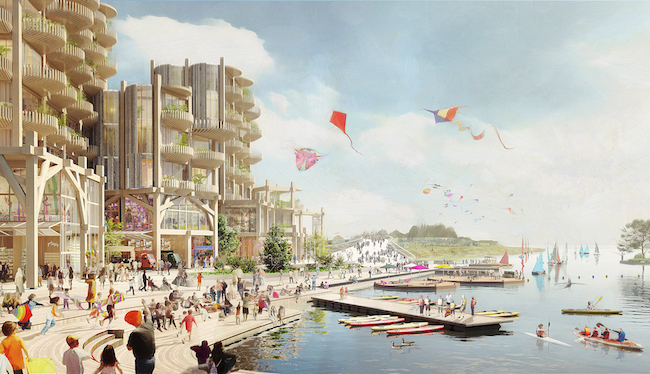
Sidewalk Labs pulls out of smart city project planned for Toronto waterfront
By Tara Deschamps, The Canadian Press
ConstructionThe Google affiliate had pitched a wide range of innovative ideas for the smart city project, but faced criticism over privacy protections

Sidewalk Labs had pitched a wide range of innovative ideas for the smart city project, but faced criticism over privacy protections. PHOTO: Sidewalk Labs
TORONTO—An ambitious plan for a high-tech neighbourhood on Toronto’s waterfront has been shelved after Google affiliate Sidewalk Labs walked away from the project, citing “unprecedented economic uncertainty.”
Sidewalk Labs said May 7 that it is abandoning its controversial smart city plans that had envisioned a state-of-the-art neighbourhood on a derelict parcel of land and drawn the ire of those concerned with the privacy implications of living or moving through an area that is under constant surveillance.
“As unprecedented economic uncertainty has set in around the world and in the Toronto real estate market, it has become too difficult to make the 12-acre (nearly five-hectare) project financially viable without sacrificing core parts of the plan we had developed,” Sidewalk CEO Dan Doctoroff said in a letter posted online that announced the news.
Doctoroff had informed Waterfront Toronto, a tripartite agency in the process of deciding whether to allow Sidewalk to pursue the plan, on Wednesday.
“While this is not the outcome we had hoped for, Waterfront Toronto offers thanks…to Sidewalk Labs for its vision, effort, and the many commitments that both the company and its employees have made to the future of Toronto,” Waterfront chairman Stephen Diamond said in a statement.
The decision marked an end to the rocky relationship between Sidewalk and Waterfront as the project was met with criticism around privacy protections and intellectual property concerns from business leaders and security experts alike.
It began in 2017, after Sidewalk won the right from Waterfront to develop a proposal for the swath of lakefront land, dubbed Quayside, in an underdeveloped corner of the city.
Critics complained about a U.S. company getting its hands on prime land that could be developed by homegrown enterprises. They also worried about what would happen with data collected from a myriad of sensors and devices throughout the neighbourhood.
In June 2018, Doctoroff and Sidewalk unveiled a 1,500-page plan showing Sidewalk was willing to spend $1.3 billion on the neighbourhood, featuring “raincoats for buildings,” heated and illuminated sidewalks, tall timber structures and affordable housing.
The company, which showed off prototypes of the raincoats and illuminated sidewalks at its office that employed 30 people, claimed the project would create 44,000 jobs, generate $4.3 billion in annual tax revenues and add $14.2 billion annually in gross domestic product for Canada.
While the initial plan involved nearly five hectares, Sidewalk unveiled a proposal in June 2019 that envisioned a project that spanned 77 hectares — 16 times the original size.
Diamond and Waterfront weren’t happy. By October, they convinced Sidewalk and Doctoroff to scale back and refine their approach to five hectares.
Sidewalk also agreed to store and process data collected from the project in Canada, pay fair market value for the land at the time of sale, team up with one or more real estate partners and allow Canadian companies to use Sidewalk’s hardware and software patents.
If the smaller project was successful, Waterfront said Sidewalk could seek to develop more land, but a formal process would need to take place.
Since that October decision, Waterfront had been weighing Sidewalk’s proposal and was meant to decide in March whether the project should move forward. COVID-19 pushed that decision back to May and even if Waterfront had given Sidewalk a green light, municipal, provincial and federal approvals would have been needed.
“This is a major victory for the responsible citizens who fought to protect Canada’s democracy, civil and digital rights, as well as the economic development opportunity,” said Jim Balsillie, co-founder of Research in Motion and a vocal critic of the project.
“Sidewalk Toronto will go down in history as one of the more disturbing planned experiments in surveillance capitalism and I hope Canadian policy-makers will reconsider how we build Canada in the 21st Century knowledge-based and data-driven economy.”
Though without its tech giant partner and amid the pandemic, Waterfront still seems to want to revitalize the area.
“Quayside remains an excellent opportunity to explore innovative solutions for affordable housing, improved mobility, climate change, and several other pressing urban challenges that Toronto — and cities around the world — must address in order to continue to grow and succeed,” Diamond said in his statement.
“Today is not the end of Quayside, but the first day of its future. Waterfront Toronto will continue to seek public and expert input as we make a next generation community at Quayside a reality.”
Toronto Mayor John Tory echoed those sentiments, saying the decision had not changed his mind about their being a “tremendous” opportunity to develop the area.
“I am extremely confident there are partners eager to undertake this endeavour,” he said in a statement.
“Our goal remains to ultimately build a neighbourhood focused on innovation in Quayside that will be the envy of cities around the world and a beacon for the future.”




